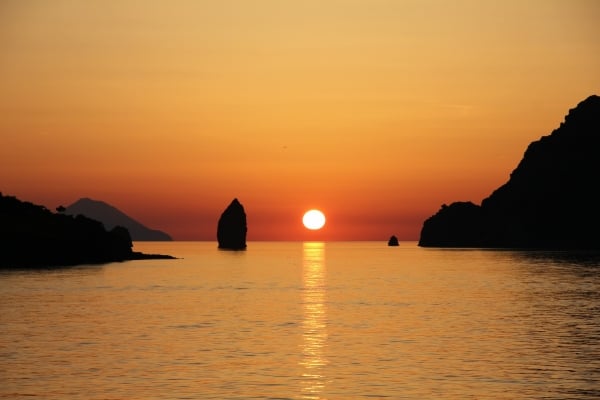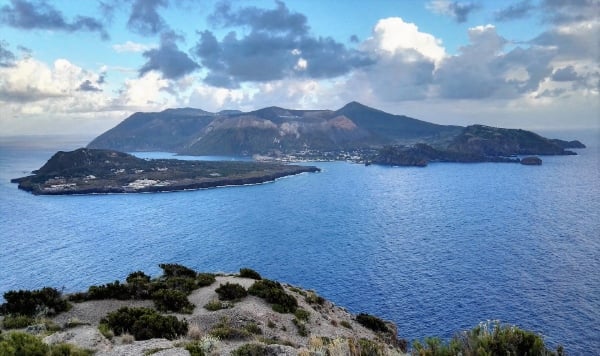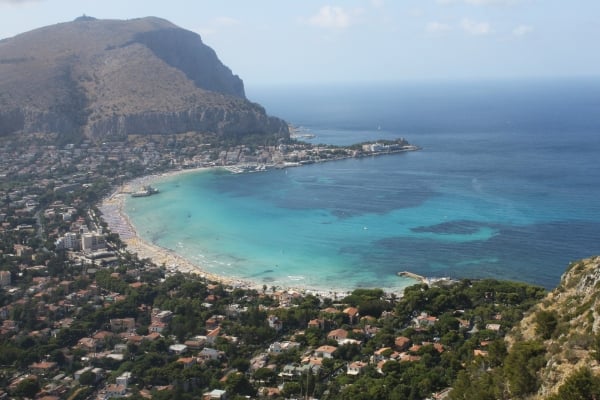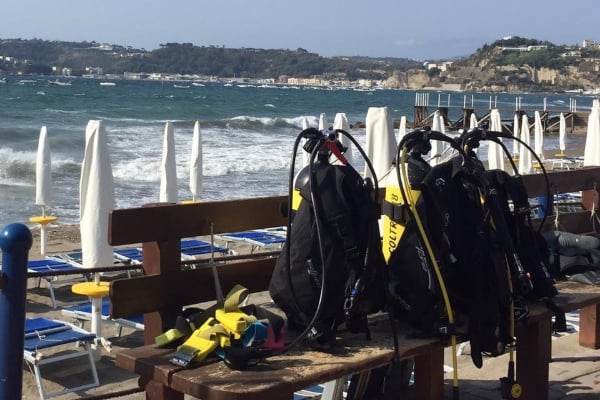These are the Best Spots to go Diving in Sicily
Scuba diving in the pristine waters lapping at Sicily’s shores is like drinking water from a mountain spring or shredding through fresh drifts of snow in the backcountry – a personalized gift from Mother Nature, herself. And diving near the largest island in the Mediterranean is the gift that keeps on giving as divers have the opportunity to not only experience the merging of the mysteries of the natural world, but also the bridging of modernity with the long-submerged past of this Italian getaway. Sicilian dive sites offer ample opportunities to explore pinnacles, caves, walls, shipwrecks and of course, wildlife. Swimming with parrotfish, barracudas, moray and conger eels and sea turtles is not uncommon, but this kind of Italian diving is most known for its geography and sunken history lurking in grottos and around neighbouring islands.
Beginners and advanced divers have the opportunity to maze through Sicily’s ancient world hiding under the ocean’s curtain for almost the entire year. From October to May, this area of the Mediterranean Sea offers visibility up to 130 feet with generally weak currents – which means clear, calm and brilliantly blue waters. There is no bad time to visit Sicily, but if you’re going on a diving holiday then August is the month to avoid the island paradise. With throngs of tourists and boat traffic, the usually peaceful ocean loses its serenity and calamity that is optimal for scuba diving.
Now it’s time to start planning and imagining this feeling: as you back roll off the boat, the sun rays fade in goodbye and the calming ripples of water envelop you into a curious world of ancient past and future discovery. You’ll lose your breath, but not because of a faulty oxygen tank instead you’ll be breathlessly in awe over Sicily’s sunken society of marine creatures and ancient artefacts – so who’s ready to explore the best diving spots in Sicily and take a selfie with 2,000-year-old statues?
Aegadian Islands
The Marine Protected Area of the Aegadian Islands lies off the northwest coast of Sicily in a cluster of five small landmasses. Favignana, Levanzo, Marettimo, Maraone and Formica run this archipelago a total expanse of 14 square miles. While each island shares the same turquoise gem crashing at its coast, Levanzo and Marettimo are the best dive sites by far.
Levanzo
With silky smooth and remote waters, Levanzo is a paradise for experienced divers. Lurking below, about 100 feet (30 meters), is a Roman shipwreck. It rests between the waters of Cala Minnola and Punta Altarella with years and years of history to discover. Amphorae and first century B.C. pottery has already been found in the shadows of this prehistoric structure. As you explore the undertow of Levanzo, you can’t miss the Grotta del Genovese where one can see 10,000-year-old art carved into Upper Palaeolithic wall paintings and neolithic drawings. But be sure to make a reservation ahead of time or you may miss out! These cave inscriptions were discovered in 1949 by a wandering Francesca Minellono, a painter from Florence on holiday. Who knows, maybe the next discovery will be made by a curious diver? In Levanzo, the possibilities and history are endless!
Marettimo
Like its neighbour, Marettimo is a red x on the treasure map for divers. This little island with its many grottos and the jagged coastline is a saltwater haven above and below. Experienced divers can search for the 17th-century iron cannon or explore the 1973 wreck of the Kent. The latter is a bit of an undertaking as it is about 150 feet (50 meters) below the surface, but certainly worth it for well-versed scuba divers. As a hotspot for diving, Marettimo has numerous opportunities for diving courses and excursions. So, if you’re rather new to the world of plunging yourself well below the depths of oxygen and sunlight then don’t fret, Marettimo attracts all kinds of travellers! Lovers’ Grotto, the Blue Grotto and the Grotto of Sighs also dot this island. Locals even say you can hear the Grotto of Sighs moaning against its cave entrapment during the peak of winter. From Sicily, catch a boat to the Aegadian Islands for a day of diving, grotto-hopping and discovery below the glassy blues of the Mediterranean.
Aeolian Islands
A tourist-must off of Sicily’s northeastern flank, the UNESCO-protected Aeolian Islands spread across the ribbons of blue into an archipelago of seven landmasses. Watched over by its namesake, the Greek god of Aeolus and the King of the Winds, these islands are a force of nature with at least eight wide caves, four volcanoes and all the diving anyone could want! Lipari, Panarea, Vulcano, Salina, Filicudi, Alicudi and Stromboli compose this string of islands, and all offer diving, diversity and incredible views of active and dormant volcanoes. Imagine your head finally breaking through the surface shattering the mirror of crystal-clear waters all around to a view of a desolate volcano off in the distance.

Lipari
The biggest and busiest of the Aeolians. Lipari offers incredible diving for both beginners and experts alike. Strap on your goggles and oxygen, jump in and check out these dive sites off of Lipari: Ever see snow underwater? The white pumice stones at Punta Castagna and the seemingly perpetual quiet enveloping you in Poisedon’s home will make you feel closer than ever to winter’s frosty landscape. Pietra del Bagno offers exceptional diving for the whole crew, whether you are a beginner or well-seasoned diver looking to break barriers! Swim among eels, scorpionfish, groupers lobster, prawns, and parrotfish at the Secca delle Formiche dive site.
Panarea
Panarea – a getaway for those who appreciate the finer things in life. Although the island’s diving welcomes all! Be sure to find the Lisca Bianca Wreck in the cobalt-blues lapping at Panarea’s shores. So far it is the only Llanishen wreck divers can reach in all of the Aeolian Islands. If for some reason you find yourself sick of the blinding blue waters, dive at Le Formiche. Le Formiche is home to rocks, sponges and seaweeds that work together with the shallow waters to give you a light show of red, yellow and orange shades.
Vulcano
Spend your day diving then relax your muscles and take a break from your hard work in the hot springs on this island. While diving near Vulcano, find the statue of Saint Mary at Quaglietto Rock, and experience one of the more historically significant dives. La Parete della Sirenetta also offers a treasure hunt to the famous stone called la Sirenetta. Just follow the vertical reef down! Also, you cannot miss the Grillo Cape when island hopping the Aeolian Islands! It’s famous for the volcanic ridge that leads the way towards the colours bouncing off the octopus, groupers, red prawns and clouds of anthias that call these depths home. No wonder photographers flock here.

Salina
The second-largest Aeolian Island stands out amongst its neighbours with its lush greenery and freshwater springs, but like the others, its diving sites are some of the best in the world. Secca del Capo is a challenge for any experienced diver with the ultimate reward: incredibly diverse reef and morphology. Be sure to watch the weather though because this dive is only possible during peak weather days. Or dive for the three peaks at the bottom of Puntra tre Pietre’s ridge. While Lipari, Panarea, Vulcano and Salina offer the most action for divers, Filicudi, Alicudi and Stromboli still offer a few dives, and regardless are worthy stops along your island-hopping tour! Not sure how to get to all of these places? Connect with La Gorgonia Diving Center. They offer half-day dives, night dives and more than 20 different diving sites!
Capo Boeo
Back in Sicily, follow Marsala’s shoreline to Capo Boeo for a day of diving or snorkelling to the underwater museum just a few meters below the surface. The shallow waters of this dive site do a poor job of obscuring the shadows of an ancient port from the city of Lilibeo, a 397 B.C. artefact. This area has seen it all, from the Roman Empire to the vandal invasions to present-day Italy. And divers can feel its immense past when they swim under the sun’s rays to the old sunken port and the seabed beyond. Divers, swimmers and snorkels alike can expect to see building remains, holds and bilges, ceramics and objects that passing ships discarded before docking centuries ago – recycling probably wasn’t around back then. No need to spend a beautiful day inside the confines of a museum, just dive at Capo Boeo!
Lampedusa
Lampedusa – a stark contrast to the rest of the Sicilian diving sites. This Pelagian island is the last stop for your Italian culture fix before the African coast rises in the distant waters. Lampedusa is a popular destination for all tourists, but especially for divers. This island in the sun is home to far more sea creatures than any other Sicilian hotspot. Here wetsuit clad travellers can come face to face with sharks, idle along with sea turtles and match strokes with dolphins or watch the manta rays ebb and flow with the currents as if they were a leaf in the wind. Spend your days searching for the Madonna del Mare statue nestled between octopi and sargo fish burrows or pay your respects to Punta Parrino – the point of protection for the island from the chaos of wind and waves. While the waters to the south of Lampedusa offer better diving because of water clarity, a trip to the northern curve of the island is a must in April as the sperm whales migrate through.
Palermo
Sicily makes it easy for divers when some of the best shipwrecks to explore, can be found just off of the coasts of its capital city. Throughout history, wrecks of all kinds have found their internal resting place in the cool depths of the seafloor, including a WWII German bomber fighter known as the Junker 52. Along with the WWII casualty, divers can plunge below to search for the Capua, the Arenella, the Paulus V and the Elpis I. Most of the wrecks are from the twentieth century, and some are in such good condition divers can imagine how the ship would look years before navigating the seas and heading for shore. Palermo’s seabound cemetery is buried well below the surface, and thus should only be a bucket list item for experienced divers. Or maybe this is just the reason you need to start diving?

San Vito Lo Capo
Only an hour away from Palermo, San Vito Lo Capo is a laid back and weathered town, dedicated to diving. Like a small surf town, it offers good vibes, beachfront dive shops and a welcoming environment for all levels of divers. The pearly sand beaches and piercing waters are the perfect access point for diving excursions at San Vito Lo Capo. Scouring the seabed under the sun’s rays, archaeologists and recreational divers have discovered pottery jars once used for the likes of wine and olive oil, anchors and other artefacts from years dating back to the 4th century B.C. Grinders and Amphorae wrecks are also in abundance and reachable by this nostalgic seaside village.
Taormina
The east coast Sicilian staple, Taormina, is another hotspot for ancient wrecks. This is where the Column lays in peace. The Column is a 2,000-year-old shipwreck from the Roman Empire. It hides from the sun’s rays 26 meters below. And just a few minutes by boat from Taormina is the Grotto Azzurra or ‘Blue Cave.’ This grotto is like no other – its waters, shelter and the whispers of light that creep through the entry point intertwine to illuminate this cavern into a mystical glow of blue. No wonder it’s Sicily’s most beautiful dive site.
To discover more about Sicily and the rest of your Italian holiday, check out Italian Breaks for where to go, where to stay and what to do.



